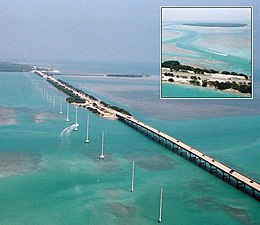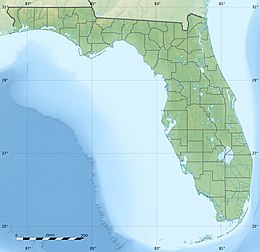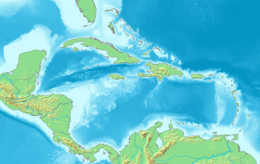
Islamorada is an incorporated village in Monroe County, Florida, United States. It is located directly between Miami and Key West on five islands—Tea Table Key, Lower Matecumbe Key, Upper Matecumbe Key, Windley Key and Plantation Key—in the Florida Keys. As of the 2020 census, the village had a population of 7,107, up from 6,119 in 2010.

The Florida Keys are a coral cay archipelago off the southern coast of Florida, forming the southernmost part of the continental United States. They begin at the southeastern coast of the Florida peninsula, about 15 miles (24 km) south of Miami, and extend in a gentle arc south-southwest and then westward to Key West, the westernmost of the inhabited islands, and on to the uninhabited Dry Tortugas. The islands lie along the Florida Straits, dividing the Atlantic Ocean to the east from the Gulf of Mexico to the northwest, and defining one edge of Florida Bay. At the nearest point, the southern part of Key West is just 93 miles (150 km) from Cuba. The Keys are between about 24.3 and 25.5 degrees North latitude.

The Great Labor Day Hurricane of 1935 was the most intense Atlantic hurricane on record to make landfall in the United States. For several decades, the powerful storm was the most intense Atlantic hurricane on record in terms of barometric pressure, until surpassed by Hurricane Gilbert in 1988, the strongest Atlantic hurricane on record in terms of 1-minute sustained winds, until surpassed by Hurricane Allen in 1980, and the strongest at landfall by 1-minute sustained winds, until it was tied by Hurricane Dorian in 2019. The fourth tropical cyclone, third tropical storm, second hurricane, and second major hurricane of the 1935 Atlantic hurricane season, it is one of four Category 5 hurricanes on record to strike the contiguous United States, along with Hurricane Camille (1969), Hurricane Andrew (1992), and Hurricane Michael (2018).

The Overseas Highway is a 113-mile (181.9 km) highway carrying U.S. Route 1 (US 1) through the Florida Keys to Key West. Large parts of it were built on the former right-of-way of the Overseas Railroad, the Key West Extension of the Florida East Coast Railway. Completed in 1912, the Overseas Railroad was heavily damaged and partially destroyed in the 1935 Labor Day hurricane. The Florida East Coast Railway was financially unable to rebuild the destroyed sections, so the roadbed and remaining bridges were sold to the state of Florida for $640,000.

Sea Base, formerly known as Florida National High Adventure Sea Base, is a high adventure program base run by the Boy Scouts of America (BSA) in the Florida Keys. Its counterparts are the Philmont Scout Ranch in northern New Mexico, the Northern Tier National High Adventure Bases in Ely, Minnesota as well as Manitoba and Ontario in Canada, and The Summit Bechtel Family National Scout Reserve near the New River Gorge National Park in southern West Virginia.
Eagle was a freighter that was sunk intentionally near Lower Matecumbe Key, Florida, to become an artificial reef and diving spot.

Henry Perrine was a physician, horticulturist, United States Consul in Campeche, Campeche, Mexico, and an enthusiast for introducing tropical plants into cultivation in the United States.
Lignumvitae Key Botanical State Park is a Florida State Park consisting of Lignumvitae Key, Shell Key, surrounding submerged lands, and a parcel at the northern end of Lower Matecumbe Key. The islands are located one mile west of U.S. 1 at mile marker 78.5, and can be reached only by private boat or tour boat.

Lower Matecumbe Key is an island in the upper Florida Keys, United States, located on U.S. 1 between mile markers 75–78.
The Glades culture is an archaeological culture in southernmost Florida that lasted from about 500 BCE until shortly after European contact. Its area included the Everglades, the Florida Keys, the Atlantic coast of Florida north through present-day Martin County and the Gulf coast north to Marco Island in Collier County. It did not include the area around Lake Okeechobee, which was part of the Belle Glade culture.
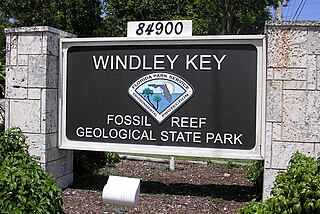
Windley Key is an island in the upper Florida Keys in Monroe County, Florida, United States. U.S. 1 crosses it at approximately mile markers 84–85.5, between Plantation Key and Upper Matecumbe Key. All of the key is within the Village of Islamorada as of November 4, 1997, when it was incorporated.
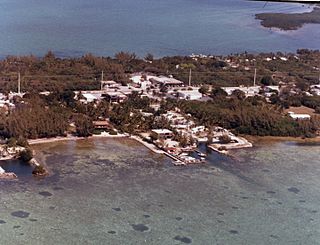
Upper Matecumbe Key is an island in the upper Florida Keys.
Craig Key is an island city in the middle Florida Keys.

Lignumvitae Key is an island in the upper Florida Keys.
The LaBranche Fishing Camp is a historic site in Islamorada, Florida, United States. On May 9, 1997, it was added to the U.S. National Register of Historic Places.
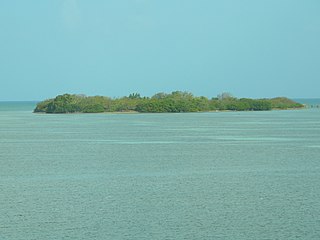
Indian Key was an unincorporated community in Monroe County and, for a while, Dade County, Florida, United States. It was located in the upper Florida Keys on the island of Indian Key and is currently a ghost town.
Lower Matecumbe Beach is a neighborhood within the village of Islamorada in Monroe County, Florida, United States. It is located in the upper Florida Keys on the southwestern half of Lower Matecumbe Key.
Matecumbe is a neighborhood within the village of Islamorada in Monroe County, Florida, United States. It is located in the upper Florida Keys on the island of Upper Matecumbe Key.

Treasure of Matecumbe is a 1976 American adventure western film directed by Vincent McEveety and produced by Walt Disney Productions. It was based on the novel A Journey to Matecumbe by Robert Lewis Taylor. The filming locations were in Danville, Kentucky, Sacramento River at Colusa, California and Walt Disney Productions' Golden Oak Ranch in California. The final scene at a beached shipwreck was filmed at Walt Disney World's Discovery Island.
